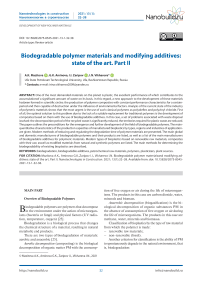Biodegradable polymer materials and modifying additives: state of the art. Part II
Автор: Mazitova A.K., Aminova G.K., Zaripov I.I., Vikhareva I.N.
Журнал: Nanotechnologies in Construction: A Scientific Internet-Journal @nanobuild-en
Рубрика: Development of new polymer materials
Статья в выпуске: 1 Vol.13, 2021 года.
Бесплатный доступ
One of the most demanded materials on the planet is plastic, the excellent performance of which contributes to the accumulationof a significant amount of waste on its basis. In this regard, a new approach to the development of these materials hasbeen formed in scientific circles: the production of polymer composites with constant performance characteristics for a certainperiod and then capable of destruction under the influence of environmental factors. Analysis of the current state of the industry of polymeric materials shows that the most urgent is the use of such classical polymers as polyolefins and polyvinyl chloride. First of all, the optimal solution to this problem due to the lack of a suitable replacement for traditional polymers is the development of composites based on them with the use of biodegradable additives. In this case, a set of problems associated with waste disposal issolved: the decomposition period of the recycled waste is significantly reduced, the territories required for plastic waste are reduced. The paper outlines the preconditions for the emergence and further development of the field of biodegradable polymers. The mainquantitative characteristics of the production capacities of manufactured bioplastics by types, regions and industries of applicationare given. Modern methods of reducing and regulating the degradation time of polymer materials are presented. The main global and domestic manufacturers of biodegradable polymers and their products are listed, as well as a list of the main manufacturers of biodegradable additives for polymeric materials. Modern types of bioplastics based on renewable raw materials, composites with their use, aswell as modified materials from natural and synthetic polymers are listed. The main methods for determining the biodegradability of existing bioplastics are described.
Biodegradation, biodegradable additives, petrochemical raw materials, polymers, plasticizers, plant sources
Короткий адрес: https://sciup.org/142226932
IDR: 142226932 | DOI: 10.15828/2075-8545-2021-13-1-32-38
Список литературы Biodegradable polymer materials and modifying additives: state of the art. Part II
- Kostin A. Bioplastics: prospects in Russia.Plastics. 2015; 3: 44-50.
- Information and Analytical Center in Russian Oil Industry. Available from: http: //www.rupec.ru/ (08.10.2020).
- Vlasov S.V., Olkhov A.A. Biodegradable polymer materials.Polymer materials: products, equipment, technologies. 2006; 7: 23-26; 8: 35-36; 10: 28-33.
- Popov A. Biodegradable polymeric materials. Container and packing. 2007; 3: 43–47.
- Anisimov A.A., Smirnov V.F., Veselov A.P. Microorganisms damage polymers.Moscow: Knowledge; 1982.
- Rybkina S.P.,Paharenko V.A., Shostak T.S., Paharenko V.V.The main directions in the field of creation of biodegradable thermoplastics.Plastic mass. 2008; 10: 47–54.
- Orekhov D.A., Vlasova G.M., Makarevich A.V., Pinchuk L.S.Biodegradable membranes based on thermoplastics.Reports of the National Academy of Sciences of Belarus. 2000; 44 (6): 100-103.
- Legonkova O., Melitskova E., Peshekhonova A. Biodegradation is the future.Container and packaging. 2003; 2: 62-63.
- Legonkova O.A., Sdobnikova O.A., Bokarev A.A.Biodegradable materials in packaging technology. Container and packaging. 2003; 6:58-66.
- Sherieva, M.L.,Shustov G.B., Shetov R.A. Biodegradable compositions based on starch.Plastic mass. 2004; 10: 29–31.
- Bogatova I.B. Polymers and Polymeric Materials in the Food Industry. Togliatti: Kassandra; 2010.
- Legonkova O. Once again about the biodegradation of polymeric materials. Container and packing. 2006; 2: 57–58.
- Buriak V.P. Biopolymers – Present and Future.Polymer materials. 2005;12: 22-27.
- Klesov A.A. Enzymatic Catalysis. Moscow: Izdatelstvo Mosk. Univ; 1984.
- Stepanenko B.N.Chemistry and Biochemistry of Carbohydrates. Monosaccharides.Moscow: Vysshaya Shkola; 1977.
- Rabek J.F. Photosensitized Degradation of Polymers.Ultraviolet Light Induced Reactions in Polymers. 1976; 25: 255-271. Available from: doi: 10.1021/bk-1976-0025.ch018.
- Yousif E., Haddad R. Photodegradation and photostabilization of polymers, especially polystyrene: review. SpringerPlus.2013;2, 398.Available from: doi: 10.1186/2193-1801-2-398.
- Daglen B.C., Tyler D.R. Photodegradable plastics: end-of-life design principles.Green Chemistry Letters and Reviews.2010; 3(2): 69-82. Available from: doi: 10.1080/17518250903506723.
- Berezov T.T., Korovkin B.F. Biological chemistry: Textbook. Debova S.S.(ed.),2nd ed. Moscow: Medicine; 1990.
- Zamyslov E. OXO-biodegradable polymeric materials. International news of the world of plastics. 2008; 7/8: 10-14.
- Legonkova O.A.Analysis of modern ideas about biodegradable polymeric materials.Paints and varnishes and their application. 2006; 4: 43–45.
- Legonkova O.A. Analysis of existing concepts of biodegradable polymer materials.Paints and varnishes and their application. 2006; 6: 37-43.
- Vinidiktova N.S., Ermolovich O.A., Gol’dade V.A., Pinchuk L.S. Strength of biodegradable polypropylene flat belts filled with modified starch.Mechanics of Composite Materials. 2006; 42(3): 389-400.
- Sherieva M.L., Shustov G.B., Beslaneeva Z.L. Biodegradable compositions based on high density polyethylene and starch.Plastic mass. 2007; 8: 46–48.
- Rogovina S.Z., Aleksanyan K.V., Prut E. Biodegradable mixtures of chitin and chitosan with synthetic polymers. Encyclopedia of a chemical engineer. 2011; 6:32–38.
- Nikitenko P. Chitosan – polymer of the future.Science and innovation. 2013; 9: 14-17.
- Vasnev V.A. Biodegradable polymers. High molecular compounds, Series B. 1997;39(12): 2073-2086.
- Leontyeva O.A. One thousand and one polymer from biostable to biodegradable. Moscow: Radiosoft; 2007.
- Shtilman M.I., Tzatzarakis M., Lotger M.M., Tsatsakis A.M. Polymer fungicides. High-molecular compounds, Series B. 1999; 41(8): 1363-1376.
- Rogovina S., Aleksanyan K., Vladimirov L. et al. Development of Novel Biodegradable Polysaccharide-Based Composites and Investigation of Their Structure and Properties.J Polym Environ. 2018; 26: 1727-1736. Available from: doi: 10.1007/s10924-017-1069-3.
- Yu L., Dean K., Li L. Polymer blends and composites from renewable resources. Progress in Polymer Science. 2006; 3(6): 576-602.


